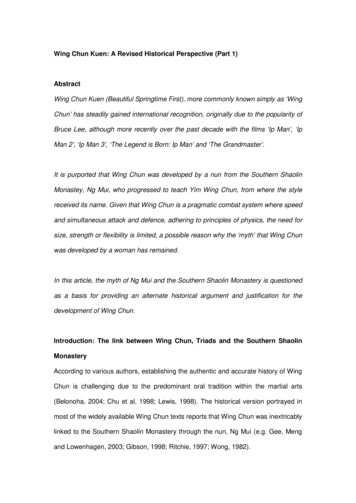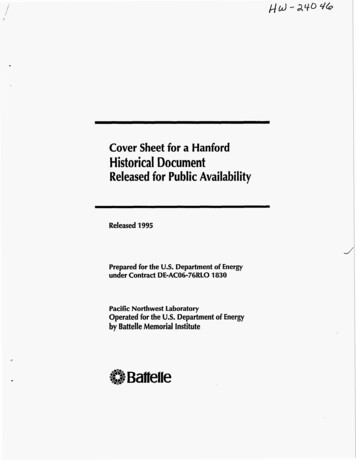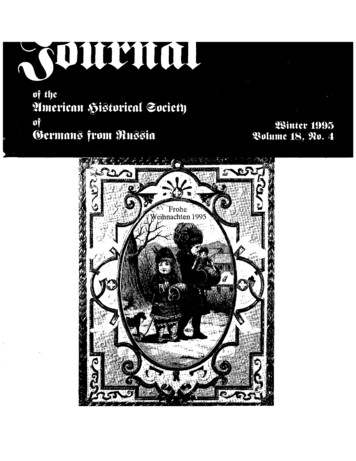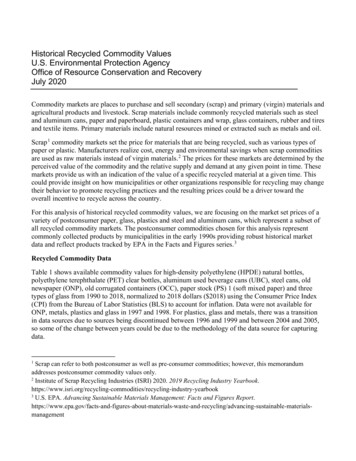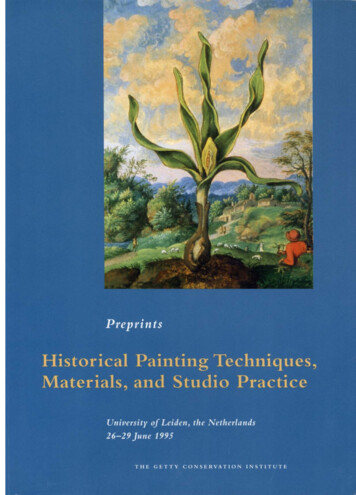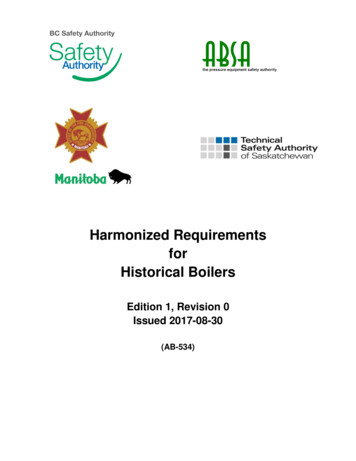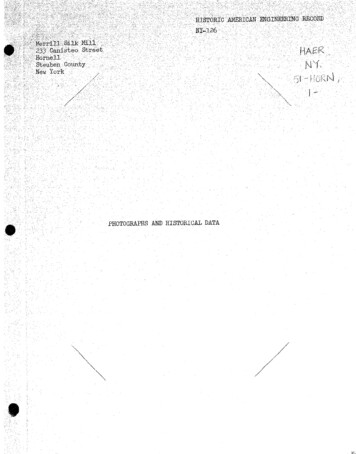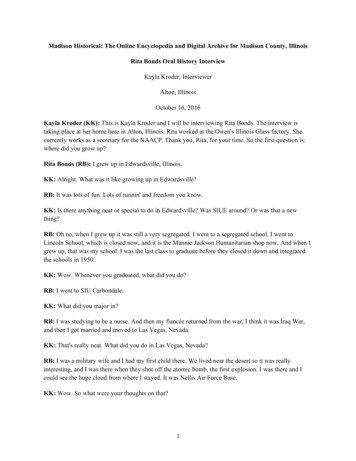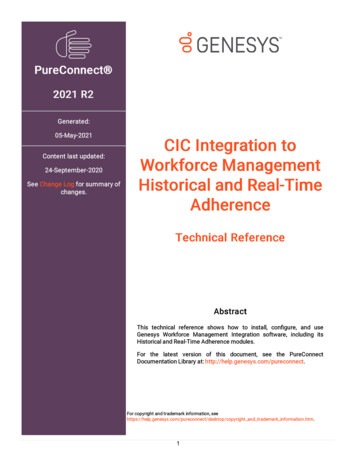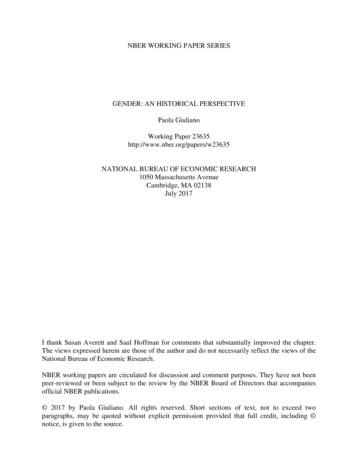
Transcription
NBER WORKING PAPER SERIESGENDER: AN HISTORICAL PERSPECTIVEPaola GiulianoWorking Paper 23635http://www.nber.org/papers/w23635NATIONAL BUREAU OF ECONOMIC RESEARCH1050 Massachusetts AvenueCambridge, MA 02138July 2017I thank Susan Averett and Saul Hoffman for comments that substantially improved the chapter.The views expressed herein are those of the author and do not necessarily reflect the views of theNational Bureau of Economic Research.NBER working papers are circulated for discussion and comment purposes. They have not beenpeer-reviewed or been subject to the review by the NBER Board of Directors that accompaniesofficial NBER publications. 2017 by Paola Giuliano. All rights reserved. Short sections of text, not to exceed twoparagraphs, may be quoted without explicit permission provided that full credit, including notice, is given to the source.
Gender: An Historical PerspectivePaola GiulianoNBER Working Paper No. 23635July 2017JEL No. N0,Z1ABSTRACTSocial attitudes toward women vary significantly across societies. This chapter reviews recentempirical research on various historical determinants of contemporary differences in gender rolesand gender gaps across societies, and how these differences are transmitted from parents tochildren and therefore persist until today. We review work on the historical origin of differencesin female labor-force participation, fertility, education, marriage arrangements, competitiveattitudes, domestic violence, and other forms of difference in gender norms. Most of the researchillustrates that differences in cultural norms regarding gender roles emerge in response to specifichistorical situations, but tend to persist even after the historical conditions have changed. We alsodiscuss the conditions under which gender norms either tend to be stable or change more quickly.Paola GiulianoAnderson School of ManagementUCLA110 Westwood PlazaC517 Entrepreneurs HallLos Angeles, CA 90095-1481and IZAand also NBERpaola.giuliano@anderson.ucla.edu
1. IntroductionSocial attitudes toward women and their role in society show remarkable differences acrosscountries, including those with similar institutions or economic development. Standard economicvariables such as the level of development, women’s education, fertility and marriage/divorceprospects, and the expansion of the service sector have been widely studied (see Goldin, 1990, fora review). Some scholars have emphasized the role played by market prices, such as the decline inchild care costs (Attanasio, Low, and Sanchez-Marcos, 2008), and by technological factors such as theinvention of baby formula (Albanesi and Olivetti, 2016). A recent literature has emphasized how thislarge variation could be the result of differences in cultural beliefs about the appropriate role of womenin society (Fernandez, 2007; Fernandez and Fogli, 2009; Bertrand et al., 2015). Several newcontributions have started to study the deep historical roots of these cultural differences (see Nunn,2009, for a review).This chapter will review the literature on the long-term historical origins of the differences ingender roles and gender gaps across societies and how they are transmitted from parents to childrenand therefore persist until today. We will review work on the historical origin of differences in femalelabor-force participation, fertility, education, marriage arrangements, competitive attitudes, domesticviolence, and other forms of difference in gender norms (such as the presence of the dowry versusthe bride price and differences in inheritance rules favoring women),We will also discuss how relatively short-term historical shocks can help in understandingdifferences in gender roles across societies. Finally, we will discuss the conditions under which gendernorms either tend to be stable or change more quickly.2. Historical origin of gender rolesIn this section, we will look at seven important long-term historical determinants ofgender roles: agricultural technology, language, geography, pre-industrial societal characteristics, familystructures, religion, and historical shocks.2.1.Agriculture and agricultural technologyA recent literature has emphasized how differences in agricultural technology or, more simply,a long history of agriculture can have long-lasting effects on the evolution of gender-role attitudes.Alesina, Giuliano, and Nunn (2013) study the historical persistence of differences in female laborforce participation. The hypothesis for their empirical analysis comes from the seminal work ofEster Boserup (1970), in which she argued that differences in the role of women in societiesoriginate in the different types of agricultural technology, particularly the differences between2
shifting and plough agriculture. Shifting agriculture, which uses hand-held tools like the hoe and thedigging stick, is labor-intensive, with women actively participating in farm work, while using aplough to prepare the soil is more capital-intensive. Unlike the hoe or digging stick, the ploughrequires significant upper-body strength, grip strength, and bursts of power to either pull theplough or control the animal that pulls it. Farming with the plough is also less compatible withchildcare, which is almost always the responsibility of women. As a result, men i n societiescharacterized by plough agriculture tended to specialize in agricultural work outside the home,while women specialized in activities within the home. In turn, this division of labor generated anorm that the natural place for women is in the home. This belief tends to persist even if the economymoves out of agriculture, affecting the participation of women in activities performed outsidethe home, including market employment, entrepreneurship, and politics.The authors document a very strong negative correlation between traditional use of theplough and female participation in agriculture in pre-industrial societies, using the Ethnographic Atlas,a dataset assembled by George Peter Murdock in 1967 and containing ethnographic informationfor 1,265 ethnic groups covering the whole world. To investigate whether plough-based agriculturecorrelates with lower female participation in all agricultural tasks or only in a few (such as soilpreparation), the authors report results on specific activities carried out in the field or outside thehome: land clearance, soil preparation, planting, crop tending, harvesting, caring for small and largeanimals, milking, cooking, fuel gathering, water fetching, burden carrying, handicraft production,and trading. Their empirical analysis carefully controls for other variables that could be correlatedwith plough use and gender roles: the presence of large domesticated animals, a measure of economicdevelopment, the fraction of land on which the ethnic group lives defined as tropical or subtropical,and the fraction of land that is defined as suitable for agriculture. Overall, the authors find thatplough use is associated with less female participation in all agricultural tasks, with the largestdeclines in soil preparation, planting, crop tending, and burden carrying. But they find that ploughuse tends not to be significantly correlated with female participation in other activities. Thisinterpretation of the correlations is fully consistent with Boserup’s hypothesis.After looking at the correlation between agricultural technology and female participation inagriculture in pre-industrial societies, Alesina et al. (2013) study whether differences in agriculturetechnology still have an impact on female labor- force participation today. A correlation betweenfemale labor-force participation in agriculture and agricultural technology in the past does notnecessarily imply that differences in historical agriculture technology affect female labor-forceparticipation today. Goldin and Sokoloff (1984), for example, document that within the northeastern3
United States, the low relative productivity of women and children in agriculture (and their lowparticipation in this sector) allowed them to participate in the manufacturing sector. In thissetting, initial female labor- force participation in agriculture is inversely related to subsequentparticipation in manufacturing, resulting in a lack of continuity of female labor- force participationover time as industrialization occurred. An interpretation based on social norms could, however, helpexplain long-term persistence.At the country level2, the authors look at differences in female labor-force participation butalso at two other measures that could reflect cultural attitudes and beliefs about the role of womenin society: a measure of entrepreneurship (the share of firms with a woman among the principalowners) and o f the presence of women in national politics (the proportion of parliamentaryseats held by women). In countries with a tradition of plough use, women are less likely toparticipate in the labor market, own firms, and participate in national politics.3To further limit endogeneity concerns, the authors also provide instrumental variable estimates.To construct their instrument, they exploit the variation in historic plough use that arose fromdifferences in societies’ geo-climatic conditions, which affected whether crops that potentiallybenefitted from the plough were cultivated. As Pryor (1985) explains, because of differences in thelength of the cropping season, the amount of land required for cultivation, and the characteristics ofthe soil (slope, depth, rockiness, etc.), crops differ significantly in the extent to which the use of theplough improves productivity. In his study, Pryor identifies crops as being either plough-positive(cultivation greatly benefits from the plough) or plough-negative (cultivation benefits less from theplough).4 The identification strategy relies on the assumption that, holding constant overall cropproductivity (for which they control for) the distinction between plough-positive and plough-negativegeo-climatic environments only impact gender roles through the plough). The primary concern withthis strategy is that the difference between plough-positive and plough-negative environments may becorrelated with geographic features that affect gender attitudes today through channels other than theTo show long- term persistence, Alesina, Giuliano, and Nunn (2013) look at differences in female labor-forceparticipation, but also at beliefs about the role of women in society in 2000. To analyze contemporary female labor-forceparticipation, they match ethnographic data to current populations using the global distribution of 7,612 language groupsfrom the fifteenth edition of the Ethnologue and the global distribution of population densities from the 2000 Landscandatabase, generating a measure of the fraction of a country’s ancestors who traditionally engaged in plough agriculture.3In a companion paper (Alesina et al., 2013), the authors examine the impact of agricultural technology on fertility. Theyfind that societies with historic plough use had lower level of fertility. The finding is consistent with the explanation thatplough agriculture reduced the benefit of having children, since they were less useful in the field.4 Plough-positive crops, which typically require extensive land preparation over a large surface area and in a very shortperiod of time, include wet rice, barley, wheat, rye, and teff. Plough-negative crops, which include crops that require littleland to produce a sufficient amount of food, crops that can be grown in rocky or sloped land, and crops with seeds thateasily take root (even in shallow soils), include three crops, root crops, maize, millet, and sorghum (Pryor, 1985).24
plough. The authors check the robustness of their results to this concern by controlling for geographiccharacteristics that are potentially correlated with the suitability of the environment for ploughpositive and plough-negative crops (terrain slope, soil depth, average temperature and averageprecipitation of locations inhabited by each country’s ancestors). The IV estimates confirm the OLSresults.In addition to determining labor-force participation, differences in agricultural technology caninfluence social norms more broadly. Boserup (1970) indeed hints at the possibility that ploughsocieties developed different social norms and marital arrangements compatible with a different valueof women in society. Her idea was not new, as anthropologists have long posited that the origins ofhousehold formation rules relate to both technology and productivity. According to Aberle (1961),“the origins of matrilineal systems are probably to be sought in technology, division of labour, typesof subsistence activities and the ecological niches in which these activities occur.” (p. 725). Goody(1976) has linked the demand for wives to the productivity of women in agriculture: in female farmingcommunities, a man with more than one wife can cultivate more land than a man with only one wife.Therefore polygamy is expected to be more common in societies with shifting cultivation. Finally, insocieties in which women do most of the agricultural work, it is the bridegroom who must pay bridewealth, while in societies in which women are less engaged in agriculture, marriage payments usuallycome from the bride’s family.To explore this hypothesis, Giuliano (2015) looks at the correlation between historical ploughuse and whether the dowry is the most prevalent mode of marriage, whether the inheritance rule in asociety is matrilineal, and if polygamy is prevalent5. She finds that in societies that used the plough, (a)inheritance rules appear to be less favorable to women—as indicated by the fact that matrilineality isless common, (b) there is less polygamy, and (c) a dowry is paid by the bride’s family. After establishinga correlation for the past, the author shows that differences in agricultural technology have a persistenteffect on social norms, lasting until today. Using da
I thank Susan Averett and Saul Hoffman for comments that substantially improved the chapter. The views expressed herein are those of the author and do not necessarily reflect the views of the National Bureau of Economic Research. NBER working papers are circulated for discussion and comment purposes. They have not been peer-reviewed or been subject to the review by the NBER Board of
